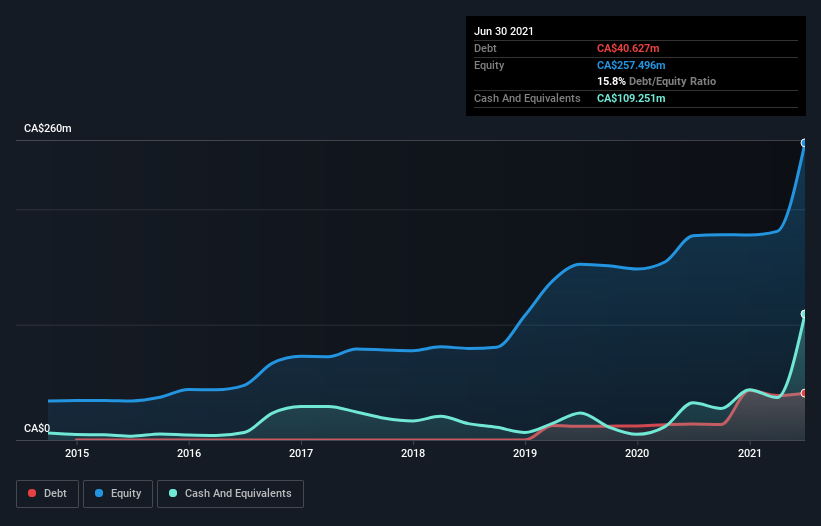Is Ascot Resources (TSE:AOT) Using Debt In A Risky Way?
The external fund manager backed by Berkshire Hathaway's Charlie Munger, Li Lu, makes no bones about it when he says 'The biggest investment risk is not the volatility of prices, but whether you will suffer a permanent loss of capital.' So it seems the smart money knows that debt - which is usually involved in bankruptcies - is a very important factor, when you assess how risky a company is. We note that Ascot Resources Ltd. (TSE:AOT) does have debt on its balance sheet. But should shareholders be worried about its use of debt?
Why Does Debt Bring Risk?
Generally speaking, debt only becomes a real problem when a company can't easily pay it off, either by raising capital or with its own cash flow. If things get really bad, the lenders can take control of the business. However, a more frequent (but still costly) occurrence is where a company must issue shares at bargain-basement prices, permanently diluting shareholders, just to shore up its balance sheet. Of course, plenty of companies use debt to fund growth, without any negative consequences. When we think about a company's use of debt, we first look at cash and debt together.
See our latest analysis for Ascot Resources
What Is Ascot Resources's Debt?
The image below, which you can click on for greater detail, shows that at June 2021 Ascot Resources had debt of CA$40.6m, up from CA$13.8m in one year. However, it does have CA$109.3m in cash offsetting this, leading to net cash of CA$68.6m.
A Look At Ascot Resources' Liabilities
According to the last reported balance sheet, Ascot Resources had liabilities of CA$5.91m due within 12 months, and liabilities of CA$61.9m due beyond 12 months. Offsetting these obligations, it had cash of CA$109.3m as well as receivables valued at CA$405.0k due within 12 months. So it can boast CA$41.8m more liquid assets than total liabilities.
This short term liquidity is a sign that Ascot Resources could probably pay off its debt with ease, as its balance sheet is far from stretched. Simply put, the fact that Ascot Resources has more cash than debt is arguably a good indication that it can manage its debt safely. There's no doubt that we learn most about debt from the balance sheet. But it is future earnings, more than anything, that will determine Ascot Resources's ability to maintain a healthy balance sheet going forward. So if you want to see what the professionals think, you might find this free report on analyst profit forecasts to be interesting.
Given its lack of meaningful operating revenue, investors are probably hoping that Ascot Resources finds some valuable resources, before it runs out of money.
So How Risky Is Ascot Resources?
We have no doubt that loss making companies are, in general, riskier than profitable ones. And in the last year Ascot Resources had an earnings before interest and tax (EBIT) loss, truth be told. And over the same period it saw negative free cash outflow of CA$29m and booked a CA$4.8m accounting loss. Given it only has net cash of CA$68.6m, the company may need to raise more capital if it doesn't reach break-even soon. Even though its balance sheet seems sufficiently liquid, debt always makes us a little nervous if a company doesn't produce free cash flow regularly. There's no doubt that we learn most about debt from the balance sheet. However, not all investment risk resides within the balance sheet - far from it. These risks can be hard to spot. Every company has them, and we've spotted 4 warning signs for Ascot Resources (of which 2 are significant!) you should know about.
Of course, if you're the type of investor who prefers buying stocks without the burden of debt, then don't hesitate to discover our exclusive list of net cash growth stocks, today.
This article by Simply Wall St is general in nature. We provide commentary based on historical data and analyst forecasts only using an unbiased methodology and our articles are not intended to be financial advice. It does not constitute a recommendation to buy or sell any stock, and does not take account of your objectives, or your financial situation. We aim to bring you long-term focused analysis driven by fundamental data. Note that our analysis may not factor in the latest price-sensitive company announcements or qualitative material. Simply Wall St has no position in any stocks mentioned.
Have feedback on this article? Concerned about the content? Get in touch with us directly. Alternatively, email editorial-team (at) simplywallst.com.

 Yahoo Finance
Yahoo Finance 
